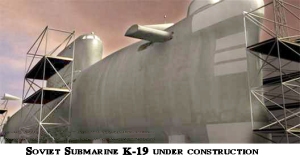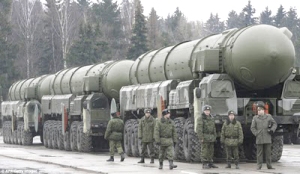Feb. 19, 2011
Soviet Submarine K-19
On 17 January 1955, the United States launched a revolution in the history of nuclear sea warfare. It was called the Nautilus, SSN-571. Until this point, submarines were constrained to limited times underwater, having to surface often to recharge their electric batteries. Thanks to a tough minded revolutionary Admiral, by the name of Rickover (“father of the nuclear navy”), SSN-571 was powered instead by nuclear reactors built under deep secrecy at Westinghouse’s Bettis Atomic Power Laboratory near Pittsburgh. These power units did not need air and could run underwater on a load of nuclear fuel for months at a time. A new generation of nuclear missiles, named Regulus, was emerging small enough to be launched from shipboard. This meant a sub could tiptoe up close to an enemy coastline before launch; shortening the warning time from 30 minutes to under 10 minutes. When Nautilus put to sea on this date, her captain sent the historic message “under way on nuclear power”.
 The Soviets were terrified. Once again the American Devils had come up with a frightening new weapon to act against them. So the keel for a Soviet nuclear powered sub was laid on October 17, 1958. Work began at a feverish pace but it was to become a two year long effort. Soviet leaders, determined to catch up, applied heavy pressure to complete the work. Soon things began to go wrong.
The Soviets were terrified. Once again the American Devils had come up with a frightening new weapon to act against them. So the keel for a Soviet nuclear powered sub was laid on October 17, 1958. Work began at a feverish pace but it was to become a two year long effort. Soviet leaders, determined to catch up, applied heavy pressure to complete the work. Soon things began to go wrong.
In early 1959, a fire breaks out while one of the ballast tanks is being assembled. Three workers are killed. Later that year, six women workers are applying insulation to the insides of a closed tank. Undetected fumes are generated during the work, and all six women are asphyxiated. The sub is to carry three ballistic missiles with nuclear 1.4 megaton warheads. These are to be fired after the boat surfaces and the missile-hatches are opened. While an electrician is installing a cover on one of the missile-tubes, it accidentally closes and crushes him to death. An engineer slips while inspecting the compartment divisions and falls to his death between two compartments.
In the fall of 1959 the hull is completed and ready for christening. Instead of the traditional woman, a man is chosen to smash the champagne bottle against the hull in an age old ceremony during launching. The bottle does not break. It bounces off the hull intact. The men of the sea are a superstitious lot, and this is taken as a very bad omen. The boat acquires the unofficial nickname of “Hiroshima”.
In July of 1960 K-19 is ordered to sea to begin shakedown trials. One of the most critical tests is a dive to maximum design depth (about 1000 feet). This dive will place all submarine systems under maximum water pressure due to the extreme depth. This will be a crucial stress of the design seals. The submarine commander is Captain Nikolai Zateyev. As the sub approaches maximum depth he receives a frenzied call from the reactor crew. There is rapid flooding in the reactor compartment. He blows emergency ballast to surface the sub immediately. On the ascent, the boat loses stability and broaches the surface lying on its port side, and barely misses colliding with one of the surface support vessels. Later the cause of the flooding was determined to be a poorly manufactured gasket which should have been replaced during earlier trials.
 During the fall of 1960 the boat continues sea trials, and covers some 10,700 miles. On one full power submerged run the rubber coating on the exterior of the submarine is observed to peel off in large chunks. She returns to port for a complete repainting.
During the fall of 1960 the boat continues sea trials, and covers some 10,700 miles. On one full power submerged run the rubber coating on the exterior of the submarine is observed to peel off in large chunks. She returns to port for a complete repainting.
In Winter 1960, during a change of the watch, the incoming crew causes an unstable reactor condition which results in actual bending of a reactor control rod. Return to port for partial disassembly of the reactor.
Next, the crew disposes of wooden planks through the galley waste disposal system. The system clogs and causes the galley to be 1/3rd flooded.
In November of 1960 K-19 is officially commissioned into the Soviet navy, and Captain, 2nd Rank Zateyev assumes formal command of the vessel.
One of its first operational orders is to participate in a war game exercise. K-19 is to enter the Atlantic without detection by NATO forces and proceed northward to await a signal from navel command. Upon order, she is to proceed under the Polar ice cap to the Berents Sea, and wage a mock clandestine missile attack against the Soviet forces there.
Successfully proceeding on the mission, she loiters south of Greenland awaiting orders. The captains’ birthday has been celebrated with a double ration of home made ice cream and wine and the crew is in high spirits. Word arrives from Naval Command to proceed with the attack.
Underway on July 4, 1961 the crew is jolted alert by a screaming alarm. On the bridge Captain Zateyev receives a terrified report that cooling water pressure in the starboard reactor had dropped to zero! Every nuclear core is designed to flow coolant continuously over the Uranium fuel rods which removes the heat generated by fission. This heat is then transferred to a turbine which turns the screws which give the ship propulsion. There are two reactors on K-19, one for each of the two ships screws. If coolant does not circulate through the core, it will quickly overheat from fissioning Uranium, and if allowed to continue, the reactor core will either accumulate enough heat to melt, releasing large amounts of radiation, or else explode, scattering highly radioactive materials throughout the crew quarters and into the surrounding waters. Either event could sink the K-19.…
(to be continued …)

